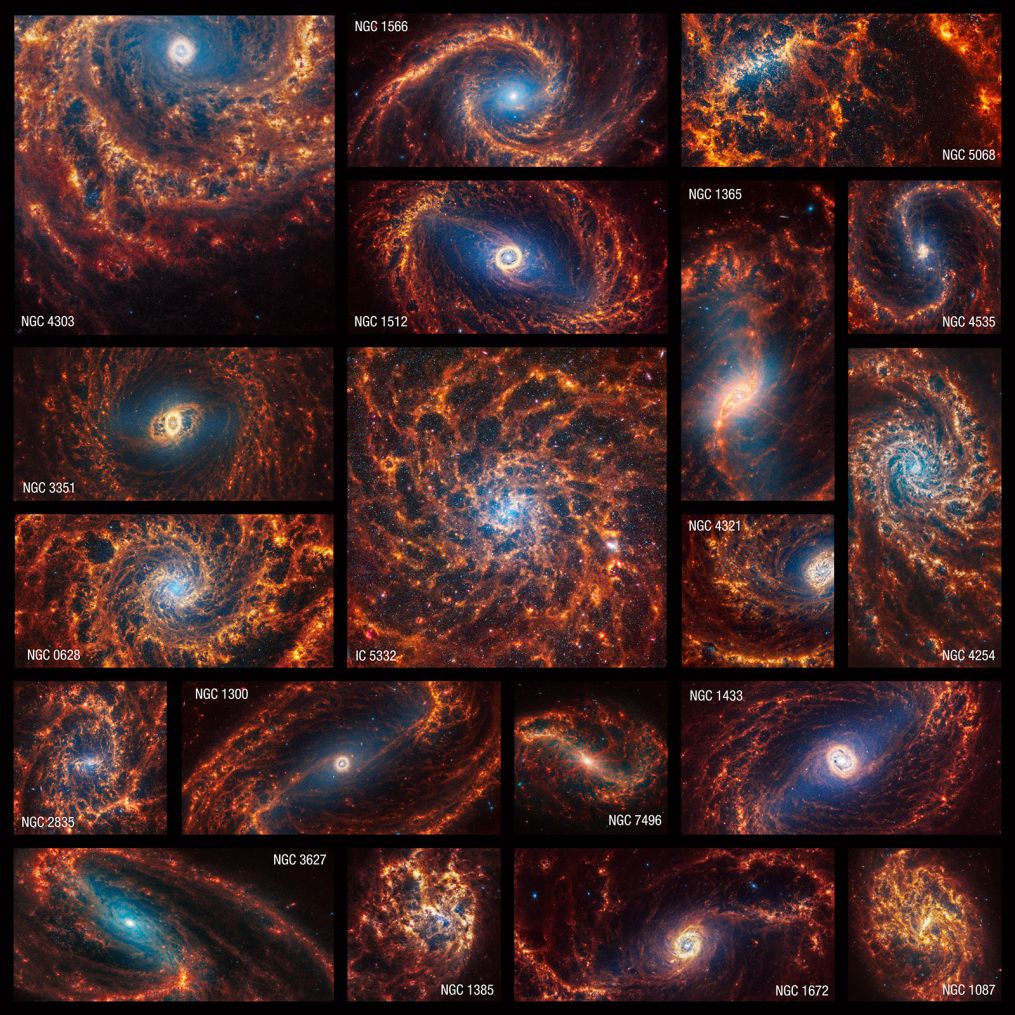(CNN) — The James Webb Space Telescope has captured scintillating images of 19 spiral galaxies, and the millions of stars they house, in a level of detail unprecedented for astronomers.
Webb's unique ability to observe the universe at different infrared wavelengths, such as near-infrared and mid-infrared, reveals the stars, gas and dust within the complex structure of each galaxy.
Astronomers think so about 60% All galaxies are spirals, and our solar system is located in one of the spiral arms of the Milky Way. Webb's observations could help astronomers better understand star formation and the evolution of spiral galaxies like ours.
When viewed from the front, each galaxy in the new images has star-laden spiral arms. At the center of every galaxy are ancient star clusters or supermassive black holes.

The James Webb Space Telescope imaged 19 spiral galaxies in near and mid-infrared light. Image credits: NASA, ESA, CSA, STScI, Janice Lee (STScI), Thomas Williams (Oxford), PHANGS
The notes came in a frame Fangs Project (High-angle resolution physics in nearby galaxies). More than 100 astronomers from around the world participate in the program, which also analyzes data from the Hubble Space Telescope, the MUSE instrument on the European Space Observatory's Very Large Telescope, and the Atacama Large Millimeter/submillimeter Array in Chile.
Data from different telescopes allow astronomers to make observations at different wavelengths of visible, ultraviolet, and radio light. Incorporating Webb's infrared data may help fill some monitoring gaps.
“Webb’s new images are extraordinary,” Janice Lee, a PHANGS member and project scientist for New Missions and Strategic Initiatives at the Space Telescope Science Institute in Baltimore, said in a statement. “It's astounding even to researchers who have studied these same galaxies for decades. The bubbles and filaments are resolved to the smallest scales ever observed, and they tell a story about the star formation cycle.”
Look inside the spirals
Astronomers used Webb's near-infrared camera to observe millions of stars, seen in sparkling blue, grouped in clusters and also distributed throughout the 19 galaxy arms. For its part, Webb's mid-infrared instrument focuses on the bright dust surrounding the stars, In addition, the red stars in the formation are coated with gas and dust that help star growth.
“This is where we can find the newest and most massive stars in galaxies,” Eric Rozolovsky, a PHANGS member and professor of physics at the University of Alberta in Edmonton, said in a statement.

This image shows observations of the galaxy NGC 4254 taken by the Webb Telescope (top left) and the Hubble Telescope (bottom right). Image credits: NASA, ESA, CSA, STScI, Janice Lee (STScI), Thomas Williams (Oxford), PHANGS
The spiral arms are actually glowing with orange-red gas in web images. The images will be used to help astronomers determine the distribution of gas and dust in spiral galaxies, as well as how galaxies are fed and star formation is halted.
“These structures tend to follow the same pattern in certain parts of galaxies,” explains Rozolovsky. “We think of them as waves, and their spacing tells us a lot about how the galaxy distributes gas and dust.”
The Webb telescope also captured large, shell-shaped spherical holes in galactic gas and dust, which were likely sculpted by exploding stars.
“These holes may have been created by the explosion of one or more stars, carving giant holes in the interstellar material,” Adam Leroy, a PHANGS member and professor of astronomy at Ohio State University in Columbus, said in a statement.
Anatomy of the Galaxy
Astronomers believe that galaxies are formed from the inside out. Star formation begins in the center of the galaxy before spreading to the spiral arms. This means that a star's distance from the galactic core depends on its age, so younger stars may be farther from the galactic core. Clusters of blue stars near the centers of each galaxy indicate older stars.
Meanwhile, some galaxies have pink-red bumps near their centers.
“This is a clear sign that there may be an active supermassive black hole,” Eva Scheinerer, a member of PHANGS and a scientist at the Max Planck Institute for Astronomy in Heidelberg, Germany, said in a statement. “Or the star clusters towards the center are so bright that they saturate that area of the image.”
According to Al-Yarwi, what interests scientists most is studying the huge number of stars revealed by the new Webb images.
“Stars can live billions or trillions of years,” Leroy said. “By precisely cataloging all types of stars, we can build a more reliable and comprehensive view of their life cycles.”

“Proud web fanatic. Subtly charming twitter geek. Reader. Internet trailblazer. Music buff.”




:quality(85)/cloudfront-us-east-1.images.arcpublishing.com/infobae/SXDWOIO7O5FMZOWUATFEXQYWTY.jpg)


More Stories
Astronauts stranded in space due to Boeing spacecraft malfunction won’t be able to return home for weeks
Download YoWhatsApp Plus 2024 Latest Updated APK for Android | WhatsApp Plus APK
What was it like to spend a year on NASA’s Mars simulation base?